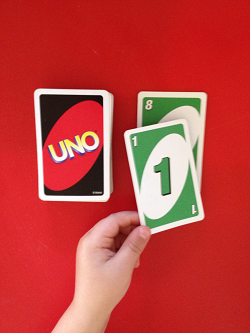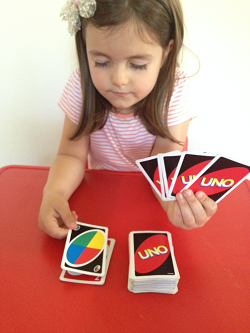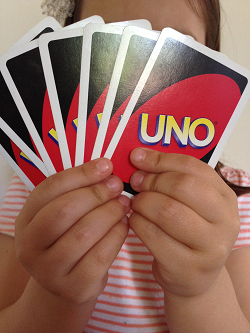UNO
is a card game suitable for the whole family. You may already have this one in your collection, but if you don’t, it’s a great one to have and can be played almost anywhere!
Objective of the game – To be first player to get rid of all the cards in your hand.
Number of players – Two or more.
How to play
 Shuffle the cards and deal seven cards, face down, to each player. The rest of the deck (the draw pile) is placed face down in the center of the table.
Shuffle the cards and deal seven cards, face down, to each player. The rest of the deck (the draw pile) is placed face down in the center of the table.- Turn over the first card in the Draw pile face up to create a Discard pile.
- The first player (normally the person to the dealer’s left) looks at his/her cards and tries to match the card on the top of the Discard pile by color, number or symbol. If there are no matches, the player must draw a card from the Draw pile. If the drawn card can be discarded, they draw again until they cannot discard a card. Then play passes to the next player.
- There are several Action cards that can change the course of the game.
‘Reverse’ – changes direction of the order of play.‘Skip’ – the next player has to skip their turn.

‘Draw Two’ – the next player will have to pick up two cards.
‘Wild’ – This card denotes all four colors, and can be placed on any card. The player can choose a new color for the next person’s turn.
‘Wild Draw Four’ – This card is just like the wild card except that the next player also has to draw four cards.
- As soon as a player has just one card left, they must yell “UNO”. If they do not, and are caught by another player, the player must draw two new cards. The first player with no cards remaining is the winner!
Educational Benefits of UNO
- Fine motor skills – holding and playing the cards can be a challenge for small hands. As your child finds the best way to do this they will develop their fine motor skills and learn to manipulate the cards with control.
 Numbers and colors – your child will get plenty of practice identifying colors and number recognition
Numbers and colors – your child will get plenty of practice identifying colors and number recognition- Matching – The game teaches your child how to match numbers and colors (visual discrimination).
- Counting – The counting of cards throughout and at the end of the game provides a fun opportunity to count with your child.
- Social interaction – Playing cards is valuable interaction with your child as this may be one of the few times they can view themselves as a peer rather than a small person! Your child will also learn to take turns and engage in friendly competition.
- Strategy – As your child gets confident with the game of UNO, you will notice them engage their intellect as they not only start thinking about the best way to win, but the best cards to play to prevent others from winning.
Variations to the game
- You may choose to keep score at the end of each game (counting totals of the cards – the person with the lowest score wins).
- Play with your cards showing to make it easier for your child to ‘fish’.
- If you only have a normal deck of cards you can still play UNO. You can read the rules on wikipedia.
Educational Toys and Games Resources
Snap – A simple, yet classic card game that your child will enjoy. Snap teaches your child to match pairs and, depending on the deck, can help your child recognize numbers or other objects featured on the cards
Go Fish – A simpler card game also suitable for children, Go Fish is ideal for first timers to the card game world. The game teaches your child to match and count pairs, and describe objects.
Tupperware Shape Sorter – There are very few educational toys out there like the Tupperware Shape Sorter. Your child can play with this toy from newborn through to pre-schooler and not only will it entertain your child throughout, but also teach them many things along the way.
Snakes and Ladders – A Snakes and Ladders board game is the perfect addition for any household with young children. Not only is the game fun but also highly educational.
Abacus – Everyone knows the abacus is an amazing mathematical tool. It’s even claimed the abacus is instrumental in giving kids a head start.

